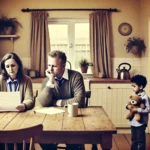Expected: Legal fees and support payments – Life After Divorce
Not expected: Duplicate items for kids in two homes (computers, clothing, etc.). Loss of discounts for shared expenses such as car insurance, cell phones, etc. Two household insurance policies, two cable, water, electrical and gas bills, etc. There may also be reduced personal income tax deductions for the children and the lower earning ex-spouse. When couples separate their total expenses can increase $20,000 – $30,000 per year. Are you prepared?
When separating, do people think about these added expenses? People are typically filled with rage and anger, fear and sadness, and some may even be unfocused, but relieved. Only after their marital breakdown, with legal advice and working through financial budgets, do they face their financial realities. Figuring out how to pay bills is often later in the separation process.
There are many articles on separation, divorce and personal finances on the Internet. Considerable research is available regarding the costs of going through a divorce. However, it’s the cost of life after divorce and the impact on your new lifestyle that parties should consider more closely before deciding to separate. Frustration impulsively pushes us to make life-altering choices. Many marital problems have no solutions. Trying to constructively work through your issues, with a trained Separation Therapist, is a wise choice. Separation is a decision that will impact each family member for many years.
Family Mediators have seen a growing number of people who made the decision to separate but are still wrestling with their unexpected financial reality. They have job instability, rising costs of living and the requirement for greater child supervision.
Part of a Family Mediator’s role in the separation process is to help people become aware of what life looks like after divorce. Financial awareness and your new ex-family lifestyle, now requires two homes instead of one, and needs to be budgeted for.
Most troubled couples fantasize they’ll be better off without their partner. He or she makes them unhappy. They may want the same house, same car, and same lifestyle — just without their partner. They want to be FREE. This isn’t realistic.
Divorce can be a long process of ongoing litigation and associated costs, not to mention the emotional wear and tear on every member of the ex-family. The new cost of life after divorce is really based on the costs associated with parenting from 2 homes and the increased child(ren)’s expenses.
If parents equally share the responsibility for their children, they can often find ways to share tax deductions. If kids live with one parent most of the time, the financially supporting co-parent may not get the child’s tax deduction, like in previous years.
It’s the child(ren) who frequently suffer during separation. Money spent on their wants and needs is reduced to make separation work. The costs once shared for kids’ activities now goes to cover the cost of two different residences.
Where children live affects how much money ex-parents spend on themselves:
- If children reside primarily with one parent, the other parent usually pays Child Support. That means by the time they’ve paid their taxes and support payments, there isn’t a lot of money left for typical day-to-day expenses.
- The parent (mom or dad) who looks after the child(ren) frequently can’t work full-time due to their responsibilities. They now have pickups, drop offs and managing the household needs: from groceries to doctor’s appointments to child(ren)’s sporting events, etc. If living arrangements are shared, both parents may be impacted equally regarding work and parenting responsibilities.
- Couples considering separation should create very detailed weekly, monthly and yearly financial budgets to understand their current and future expenses, including where they can trim their spending:
-
- What current expenses are possible if the expenses are shared?
- Is the chosen lifestyle driven by the income of only one spouse?
- Does either parent have an inconsistent work history or a career that makes expense planning impossible?
If a couple look at their budget and realize separating is in fact a financial impossibility, they have a few choices:
- Find ways to cut expenses.
- Go for counseling and learn how to create a positive financial path forward and work together.
- Co-exist amicably under one roof as a separated couple. Re-visit having separate homes when the kids are older or there’s more money.
Having the same income to support two homes instead of one is one of the most common issues in separation and divorce. Remember, budget for added costs and expenses for the divorce process itself.
A healthy divorce is one where both parties move forward in a mature way without hurting each other. They let go of the marriage and the emotions connected with separation. The healthier they are emotionally, the more effective they can make financial decisions and plans.
When there’s financial struggle, a happy, healthy post-divorce life is drastically reduced and may result in trading one state of unhappiness for another. Starting to examine financial budgets early in the separation process will help create an easier path and a realistic financial future.
When Children Do Well, Parents Do Well
When Parents Do Well, Children Do Well
























